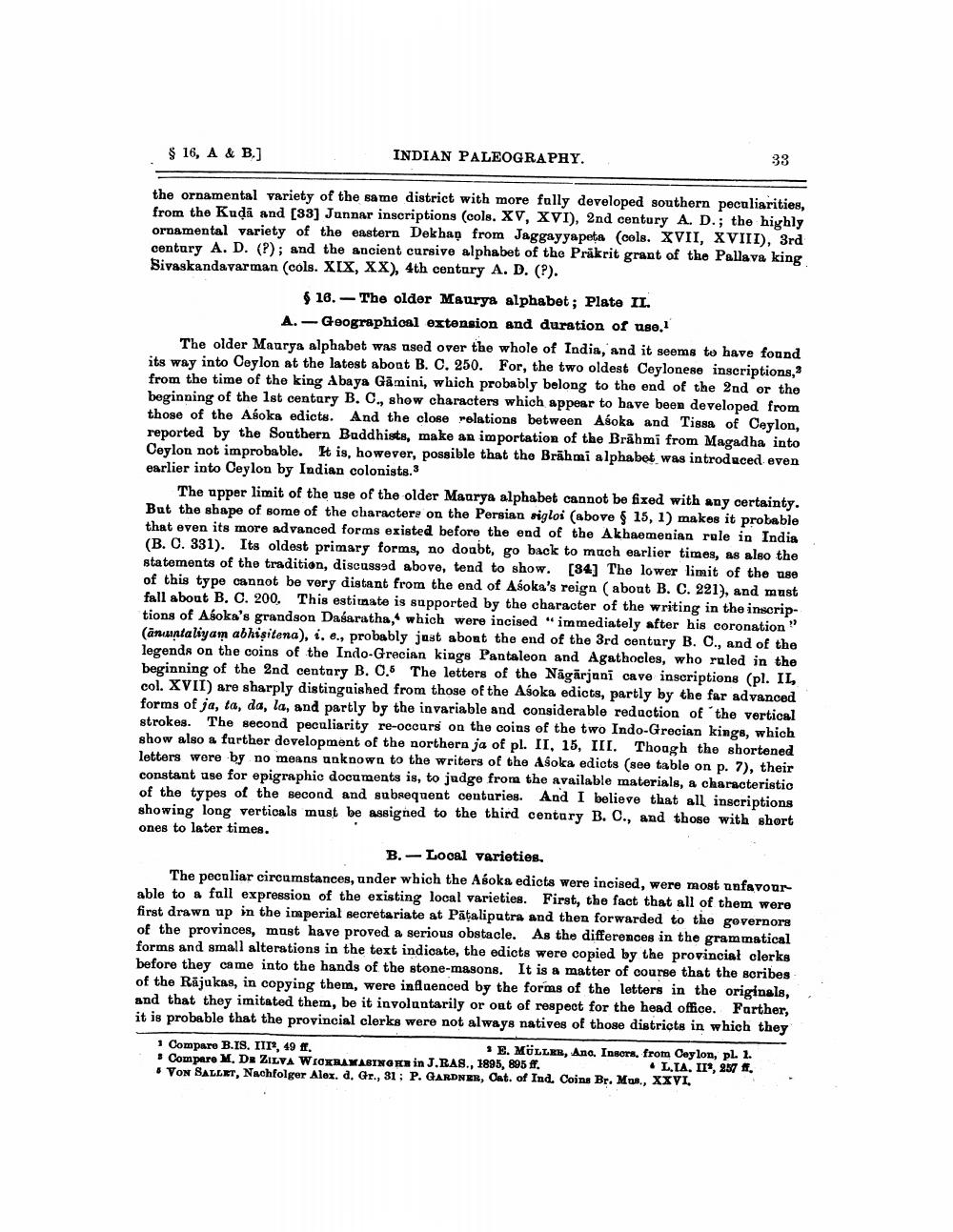________________
$ 16, A & B.]
INDIAN PALEOGRAPHY.
33
the ornamental variety of the same district with more fully developed southern peculiarities, from the Kudā and [33] Junnar inscriptions (cols. XV, XVI), 2nd century A. D.; the highly ornamental variety of the eastern Dekha9 from Jaggayyapeta (cols. XVII, XVIII), 3rd century A. D. (?); and the ancient cursive alphabet of the Prakrit grant of the Pallava king Bivaskandavarman (cols. XIX, XX), 4th century A. D. (?).
$16. - The older Maurya alphabet; Plate IL.
A. - Geographical extension and duration of use. The older Maurya alphabet was used over the whole of India, and it seems to have found its way into Ceylon at the latest about B. C. 250. For, the two oldest Ceylonese inscriptions, from the time of the king Abaya Gamini, which probably belong to the end of the 2nd or the beginning of the 1st century B. C., show characters which appear to bave been developed from those of the Asoka edicts. And the close relations between Asoka and Tissa of Ceylon, reported by the Southern Buddhists, make an importation of the Brāhmi from Magadha into Ceylon not improbable. It is, however, possible that the Brāhmi alphabet was introduced even earlier into Ceylon by Indian colonists.8
The upper limit of the use of the older Maurya alphabet cannot be fixed with any certainty. But the shape of some of the characters on the Persian sigloi (above $ 15,1) makes it probable that even its more advanced forms existed before the end of the Akhaemenian role in India (B. O. 331). Its oldest primary forms, no doubt, go back to much earlier times, as also the statements of the tradition, discussed above, tend to show. [34] The lower limit of the use of this type cannot be very distant from the end of Asoka's reign (about B. C. 221), and must fall about B. C. 200, This estimate is supported by the character of the writing in the inscriptions of Asoka's grandson Dasaratha, which were incised "immediately after his coronation" (anuntaliyam abhişitena), i, e., probably just abort the end of the 3rd century B. C., and of the legends on the coins of the Indo-Grecian kings Pantaleon and Agathocles, who ruled in the beginning of the 2nd century B. 0.6 The letters of the Nāgārjuni cave inscriptions (pl. IL, col. XVII) are sharply distinguished from those of the Asoka edicts, partly by the far advanced forms of ja, ta, da, la, and partly by the invariable and considerable reduction of the vertical strokes. The second peculiarity re-occurs on the coins of the two Indo-Grecian kings, which show also a further development of the northern ja of pl. II, 15, III. Though the shortened letters were by no means unknown to the writers of the Asoka edicts (see table on p. 7), their constant use for epigraphic documents is, to judge from the available materials, a characteristio of the types of the second and subsequent centuries. And I believe that all inscriptions showing long verticals must be assigned to the third century B. C., and those with short ones to later times.
B. - Local varieties. The peculiar circumstances, under which the Asoka edicts were incised, were most unfavour able to a full expression of the existing local varieties. First, the fact that all of them were first drawn up in the imperial secretariate at Pātaliputra and then forwarded to the governors of the provinces, must have proved a serious obstacle. As the differences in the grammatical forms and small alterations in the text indicate, the edicts were copied by the provincial clerks before they came into the hands of the stone-masons. It is a matter of course that the scribes of the Rājukas, in copying them, were influenced by the forms of the letters in the originals, and that they imitated them, be it involuntarily or out of respect for the head office. Farther, it is probable that the provincial clerks were not always natives of those districts in which they
1 Compare B.IS. III, 49 ff.
E. MÖLLER, Ang. Insera, from Ceylon, pl 1. Compare M. De ZILVA WOKRAXASINGH in J.RAS., 1895, 895 f.
LIA, II, 257 . • VON SALLET, Nachfolger Alex. d. Gr., 31 ; P. GARDNER, Oat. of Ind. Coins Br. Mus., XXVI.




